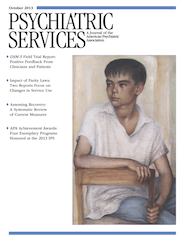Subjective Distress After Seclusion or Mechanical Restraint: One-Year Follow-Up of a Randomized Controlled Study
Abstract
Objective
Patients who participated in a randomized controlled trial comparing subjective distress and traumatic impact after seclusion or mechanical restraint were interviewed about the coercive measure about one year later.
Methods
Between May and December 2006, patients were interviewed about one year after experiencing seclusion or mechanical restraint as an inpatient. Items from the Coercion Experience Scale (CES) were used in the original and the follow-up studies to assess distress on a 5-point scale, with higher scores indicating greater distress. Patients were also asked about subjective feelings about the coercive measure and completed the Impact of Event Scale–Revised (IES-R) to assess symptoms of posttraumatic stress disorder (PTSD).
Results
Sixty (59%) of the 102 patients in the original sample were included for follow-up. Although the original study found no differences between patients who experienced seclusion or mechanical restraint, the follow-up study found significantly higher mean scores for CES items among patients who had experienced mechanical restraint (2.5 and 3.7, respectively, p<.001). IES-R scores did not differ significantly. IES-R scores for two patients who experienced mechanical restraint and one who experienced seclusion indicated probable PTSD. Patients reported experiencing a wide range of negative feelings during the measure, most frequently helplessness, tension, fear, and rage. However, 58% reported some positive effects. Contact with staff was most helpful in alleviating distress during the coercive measure.
Conclusions
Contrary to the original study, the follow-up study suggested that seclusion might be a less restrictive alternative for most patients. The incidence of PTSD seemed lower than expected.



